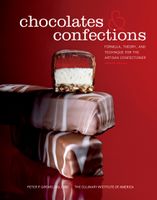Advertisement
Crystalline Confections
Appears in
By Peter Greweling and Culinary Institute of America
Published 2007

The category of crystalline confections includes perennial favorites such as fondant and fudge, liquor cordials, cherry cordials, maple candy, pralines, and even rock candy.
The two crystalline confections that are the most similar are fondant and fudge. Fondant is a system of minute sugar crystals surrounded by a saturated sugar solution; fudge is simply fondant with the addition of milk, fat, and flavoring—often chocolate. All crystalline confections are based on creating a supersaturated sugar solution and then promoting crystallization of that solution using varying degrees of agitation. In almost all cases, the desired result is a smooth texture achieved by agitating the syrup vigorously, promoting the immediate formation of many very small sugar crystals. Only in the case of rock candy is the desired result large sugar crystals, and here, the larger the better. To form these large sugar crystals, the syrup is left undisturbed without any agitation for days as the crystals slowly form. While the smoothness of fondant and fudge is determined by the size of the sugar crystals, its relative firmness is determined by the moisture content. As in all sugar confectionery, the moisture content is controlled by the temperature to which the syrup is cooked, and therefore the concentration of sugar in the syrup. It is interesting to note that crystalline confections, most notably fudge and pralines, are often thought of as “homemade” products. In spite of the fact that these candies are often made by nonprofessionals, achieving the proper crystal size and moisture content, and therefore a smooth creamy texture, is not a simple feat. A basic understanding of the principles of crystallization will be beneficial to the artisan confectioner in making crystalline confections with the correct texture every time.

